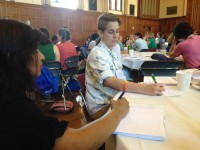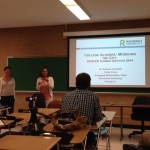Victor Donnay’s plenary address during the 2015 SENCER Summer Institute had a clear goal—to show the connection between mathematics and the issues people care about.
Victor, who is the William R. Kenan, Jr. Chair of Mathematics at Bryn Mawr College and an advisory board member for NCSCE’s Engaging Mathematics initiative, has the same goal for his students.
Victor uses various assignments to make the connection between mathematics and real world issues clear. During his plenary, Victor shared three examples of such assignments with the audience.
In the first assignment Victor shared, students are instructed to take a homework problem and describe in one paragraph how the mathematics involved might be used to address a real world issue. Students post their paragraphs online and read three others posted by their classmates. From this assignment, something like the concept of related rates in calculus transforms from a general question about how quickly two planes move away from each other into a question about how vocabulary growth rates differ for children born into different socioeconomic classes.
In Victor’s second assignment, students find an article about mathematics in a newspaper or on the web and post it to the class website with a one-paragraph summary. They then read three other summaries and write comments on them. This assignment exposes students to real-world, relevant, and newsworthy mathematics.
In the third assignment, which serves as a final project in Victor’s multivariable calculus course, students pick a world topic that interests them and a topic they learned from the course and show how they are connected. Students present their work at a reception where they can discuss their projects with a general audience.
Victor is also highly focused on issues of environmental studies and sustainability. He chairs the college’s Sustainability Leadership Group, directs the Environmental Studies program, and has taught numerous courses that integrate sustainability with mathematics.
In his mathematics of sustainability courses, he focuses on social, economic, and environmental issues, because all three have an impact on sustainability. His students have studied the Rwandan genocide, population growth models, and tipping points.
Victor worked with TED-Ed to create a short animated video on how tipping points relate to the mathematics of climate change. In the video, titled “Our Chaotic Climate,” chaotic billiard motion explains how a two-degree increase in Earth’s average temperature can lead to substantial consequences.
Victor also incorporates service learning into his mathematical modeling and sustainability course, allowing students to work to make a real difference on their campus and in their community. Student projects range from examining the energy footprint for a renovation of the science building to measuring the level of safety of bike routes. Two of Victor’s students were publicly recognized for their efforts in helping Haverford Township apply for a grant from the Pennsylvania Energy Department Authority to help fund a geothermal energy system for the Community Recreation Environmental Center, a direct result of their service-learning project that explored the center’s options for alternative energy sources.
Students react well to being able to make a difference through their course work. As one of Victor’s students said, “The end results of all the projects were pretty satisfying; it made you feel like you were making a contribution and that you might actually be able to affect something.”
Reactions from the plenary audience were largely positive as well. Overheard were comments from attendees along the lines of, “I never knew this was math!” Victor’s plenary did a great job of showing how mathematics relates to current world problems and topics in many other disciplines, from environmental sustainability to social justice. He helped SSI 2015 attendees see that mathematics is accessible, exciting, and important.
For more from Victor’s plenary, please access these resources:




